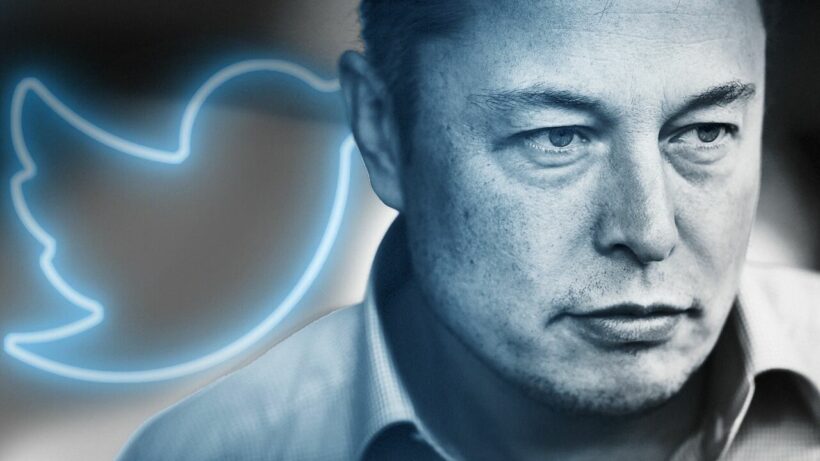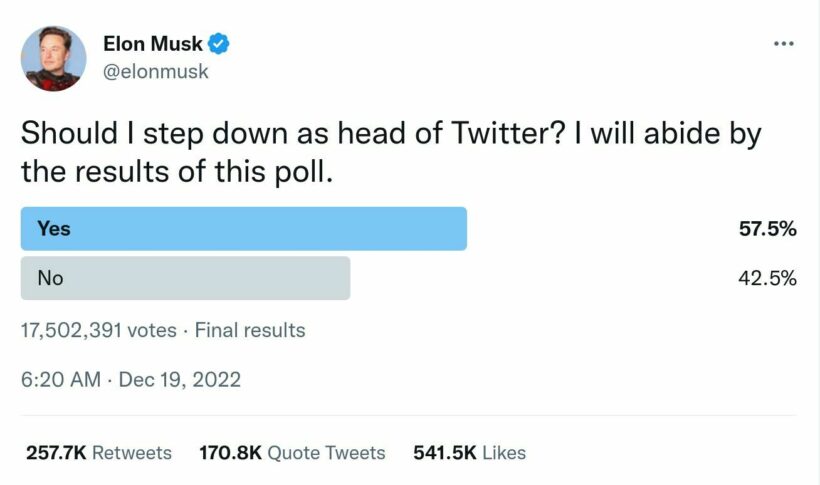Twitter poll respondents tell Musk to step down, so he changes rules

Elon Musk’s Twitter has been the definition of a hot mess. After the latest round of controversies, Musk – now fallen to the world’s second richest man – launched a poll asking if he should step down. When the poll didn’t go the way he planned (or did it?!), he changed the rules of who could participate in future polls. Musk’s opponents hate him for the same reason his supporters love him – the random, rash decisions and chaos created by him.
On Sunday, Elon tweeted a poll: “Should I step down as the head of Twitter? I will abide by the results of this poll.” Over 17.5 million people voted with 57.5% saying yes and 42.5% saying no.
Musk has not yet responded confirming that he will, in fact, abide by the poll votes. But he did comment that, from now on, only Twitter Blue subscribers who pay to be verified will be allowed to vote in future policy-related polls on the platform.

Meanwhile, rumours swirled that Elon had already decided to step down as the head of Twitter; or was being forced to. The third biggest stakeholder in Tesla, the company Musk is supposed to be running while seemingly distracted by Twitter tomfoolery, called for Elon to step down from Tesla amid stock value losses of nearly 63% (which is why Musk is no longer the richest man in the world).
A photo surfaced of Elon Musk next to alt-right hero and liberal villain Jared Kushner, surrounded by people in Middle Eastern garb at the World Cup. The men were rumoured to be linked to Saudi Prince Al-Waleed Bin Talal, who dumped his nearly 35 million shares into the acquisition of Twitter, quietly becoming the second largest shareholder in Twitter, after Musk.
Gossip spread of an overheard conversation of displeasure with the course of Twitter under Musk, fueling speculation that investors were calling on Musk to resign and this poll was just a way for Elon to step down by the will of the people, and not at the command of powerful investors.
How did it get here?!
So, how did the Elon Musk Twitter takeover become such a hot mess? Well, it was basically that way from the start. First Musk made what almost seemed like an off-the-cuff bid/threat to buy Twitter, but then got serious about it, and later (metaphorically, like a drunk during a regrettable one-night stand) sobered up and tried to pull out. But he was in too deep legally and after months of litigation that he looked likely to lose, Elon reversed course and bought the social media giant.
The first week or two was like a tornado hitting. He immediately fired most of the senior staff and followed that up with pink slips for about half the entire staff. After an ultimatum asking employees to sign a pledge to work “hardcore” or to walk away with severance, there were mass resignations.
At the same time, Musk announced that the Twitter Blue checkmarks that were for verified accounts to prevent people from imitating celebrities and important people would now be a pay-to-play scheme, perhaps to make up for the massive loans needed for his US$44 billion takeover.
Within a day of users being able to pay $8 to be verified as whoever they wanted to be, Pepsi announced “Coke is better.” Chiquita announced they had overthrown the Brazilian government. Fake Tesla accounts posted about crashes and Nintendo tweeted Mario with his middle finger extended.
But the mother of fake but verified tweet fallout came when a fake account for pharmaceutical giant Eli Lily posted that insulin would now be free, causing their stock to plummet and costing the company billions.
At the same time, the push for hardcore work – long hours and sleeping in the office – brought threats for government officials at Twitter’s headquarters, as the San Francisco buildings were zoned for business not sleeping. Elon responded by threatening to move the headquarters out of the California Bay Area.
Advertisers down, hate speech up
Amid all this, advertisers were dropping like flies – half scared of policies that seemed more like those of a child than of a billionaire business titan, and half because of the extremism that immediately crept back onto Twitter. Studies showed the use of racial slurs skyrocketed, and Elon himself retweeted debunked right-wing extremist conspiracy theories. Musk tweeted a threat to advertisers to try to get them to stay.
Then came the polls. After a poll asking if disgraced former US President Trump should be reinstated, his account was restored along with dozens of extremists and white supremacists previously banned for hate speech and incitement. A few days later, after pledging not to censor the @ElonJet that shared public data about where Musk’s private jet was, he banned the account and then banned every journalist that covered the story.
So much for free speech absolutist Musk. The European Union even threatened sanctions against Twitter, saying EU law “requires respect of media freedom and fundamental rights.”
Users, including @ElonJet, started jumping ship, with posts and bios including links to new social media accounts on sites like Post and Mastadon becoming a common trend. This angered Musk so he started banning posts that linked to social media platforms where departing users could be found.
A law-savvy user posted that Elon’s random banning of users he disagrees with, and of people linking to their new accounts, shifts the status of Twitter from a social media site to an editorial media site, which could make Musk and Twitter liable for any and all illegal content posted by users on the site. The policy, and the tweet announcing it, were quietly removed from Twitter shortly after.
Now, will the tumultuous reign of Elon Musk at Twitter truly come to a close? Will a figurehead be installed as CEO to calm the nerves of users and investors? Keep in mind – even if he steps down, Musk still owns Twitter. We will all wait for the next chaotic tweet.
Latest Thailand News
Follow The Thaiger on Google News:


























